Friday Jan 24, 2025
Friday Jan 24, 2025
Wednesday, 8 January 2020 00:00 - - {{hitsCtrl.values.hits}}
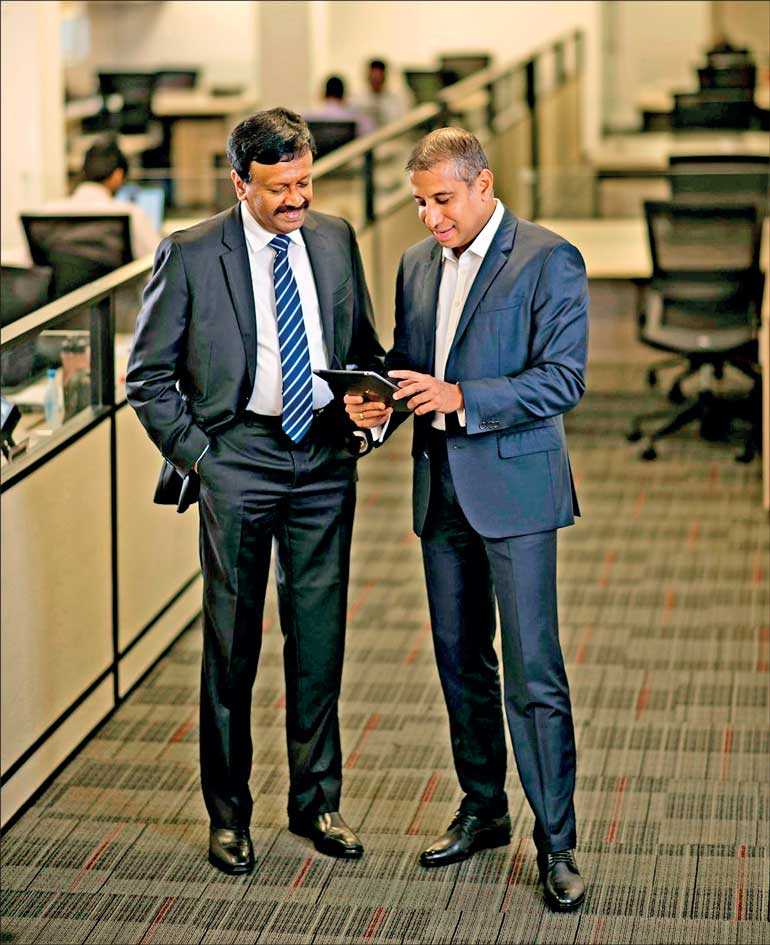
By Nisthar Cassim
Ishara Nanayakkara, a dynamic business tycoon who won the title of the Youngest Entrepreneur in Asia Pacific in 2012 and the brains behind the success of the LOLC Group, recently topped the rich list of Sri Lanka. Kapila Jayawardena, a banking veteran and ex-Citi Bank Country Head to Sri Lanka and Maldives as well as the LOLC’s Group Managing Director and CEO, steers this giant group in the right direction. Hot on the heels of announcing a historic $ 603 million or Rs. 110 billion deal on the sale of controlling stake in Cambodia’s largest microfinance company PRASAC, this power duo sat with the Daily FT for an exclusive interview on LOLC's journey so far, challenges faced, strategies adopted and future plans. They also explained the background to the record Cambodian deal. 
Q: First things first. Are you the richest man in Sri Lanka right now and how do you feel about that?
Ishara: I don’t like to be labelled like that. It is an accolade, but not a goal, at least for me.
Q: Then what are your goals?
Ishara: You will see when we get there (answers with a bright smile).
Q: LOLC was your first acquisition in the financial world and what was the thinking behind it?
Ishara: My father was the one who invested in LOLC back in the year 2000. He was a self-made entrepreneur and was the best I have known to this day. The intuition and the pioneering spirit I have come from him. He started off Ishara Traders in 1973 and is known in the automobile industry as the pioneer in importing reconditioned vehicles to the country. With his banking background, he saw tremendous potential in LOLC and was excited to invest. I was introduced to the business world at a very young age and was sent to Japan as a teen for extensive training. Therefore, investing in LOLC gave a good platform for me to challenge myself and start from scratch in the financial world.
Q: What is the secret to your success?
Ishara: I am a strong believer in keeping things simple. My building blocks in business are pretty basic. But what is important is to be driven and not lose sight of your goals. Positive thinking comes naturally to me and I am lucky to have business instincts and perseverance in my blood. People around me find me to be an unconventional, outside-the-box thinker. I always encourage my team to dream big, that is how the passion lasts.
Q: What makes LOLC different from other market players in Sri Lanka?
Ishara: LOLC is a Sri Lankan corporate with a substantial international footprint. We have operations in over 10 countries with a rapidly growing pipeline, and all these successful expansion plans within recent years. So I think we are a Sri Lankan global player. 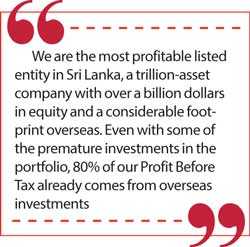
Kapila: What is unique about LOLC is its agility. Agility in the business model, in leadership and decision-making, in its people and corporate culture. We embrace change quite positively and swiftly.
Q: Can you elaborate on your global expansion?
Ishara: We ventured into overseas markets in 2007, when we were invited by FMO, the Dutch Development Bank, to invest in PRASAC, a Cambodian Microfinance Institution (MFI), because they felt our expertise as a practitioner in the micro and SME market would add value. And it did. PRASAC became the largest MFI in Cambodia in less than a decade with our involvement. It is also important to mention the encouragement and supportive role played by the Central Bank of Sri Lanka in granting the necessary approvals to invest overseas. With this exposure in foreign markets, we realised the untapped potential in the region and looked for more investment opportunities.
Today, we have micro finance operations in Cambodia, Myanmar, Pakistan, Indonesia, Philippines, Nigeria and Zambia and along with a few other handpicked destinations in the pipeline.
Q: Has your global expansion been successful?
Kapila: We are the most profitable listed entity in Sri Lanka, a trillion-asset company with over a billion dollars in equity and a considerable footprint overseas. Even with some of the premature investments in the portfolio, 80% of our Profit Before Tax already comes from overseas investments. I think you have your answer there.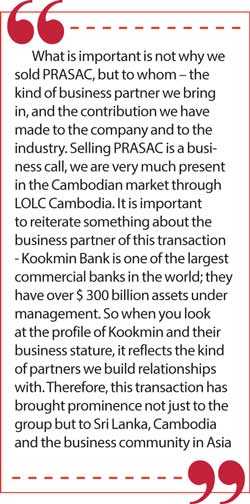
Q: So it all began with PRASAC?
Ishara: Yes, it all began with PRASAC. This is our maiden overseas investment made in line with the group’s long-term vision. We initially invested in a stake of 18%. At the time, PRASAC had a book of $ 33 million, making a profit of $ 1.9 million. As we increased our strategic involvement and contribution, so too did we increase our holding to 22.5%. PRASAC gave us an opportunity to propagate our homegrown microfinance model beyond the shores of Sri Lanka. We shared best practices, good governance and knowhow from one another.
Fast forward 10 years, we were presented with an opportunity to increase our stake to 70% as the existing shareholders at that time - FMO, Belgian Investment Company for Developing Countries (BIO) and Dragon Capital - two prominent Development Finance Institutions (DFIs) and a private equity fund, had to exit as per their development mandate.
Today, PRASAC stands strong at the helm of microfinance with a lending book of $ 2,535 million, $ 1,727 million in deposits, $ 2,987 million in total assets and a customer base of 418,000 as at November 2019. I must say that the commitment and the dedication of the PRASAC management team accelerated this growth momentum.
I know these numbers are mindboggling, especially given the fact that MFIs in Cambodia have the highest financial inclusion and the lowest non-performing loans (NPL) ratios in the region. If you look at it carefully, the high level of financial inclusion has offered customers access to formal lending channels as opposed to the informal moneylenders who charge exorbitant interest rates, whilst also stimulating recurrent economic activity, especially at the bottom of the pyramid. 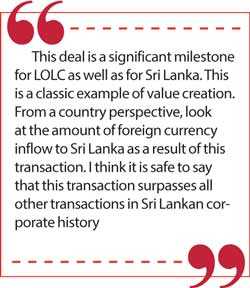
For example, we not only finance farmers for their agriculture machinery but also offer loans for equipment that is used in value chain activities. This upgrades the entire process from manual to mechanisation, which in return offers them higher productivity. Snowballing this cycle results in rapid growth in GDP, which is what is evident in Cambodia, as the country with the highest GDP growth in South East Asia.
But none of this is possible if you don’t have a proper regulatory regime and governance structure in place. This is the decisive factor. The prime reason for the resilience and sustainability of the Cambodian microfinance sector therefore in my opinion is due to the timely and positive intervention of their regulator, for example, the self-regulation imposed by the Cambodian Microfinance Association (CMA), close monitoring and approval of shareholders of microfinance companies, the imposition of interest rate caps, active involvement in understanding the strategies of microfinance companies, etc. These actions of the regulator have ensured a level playing field for all players, and most importantly controlled the over-indebtedness of the borrower which has resulted in the lowest NPL ratios in the region.
I have been involved in the microfinance industry for over 17 years now, and believe me, we have had our fair share of macroeconomic challenges in setting up businesses offshore. Therefore, I can confidently say that the facilitation role played by the Cambodian regulator for its market players is a critical success factor and I hope that other markets will follow suit.
Q: So why then did you sell PRASAC?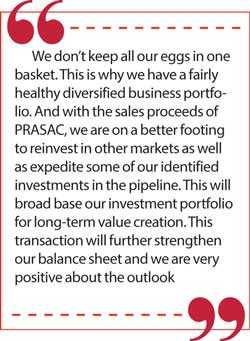
Ishara: Identifying budding enterprises and nurturing them to reach greater heights is one of our core competencies. This is why we invest in entities with potential. We identify gaps, place our systems and processes, align them with our unique business model and facilitate rapid growth. We have mastered this regardless of the territory we operate in – look at CLC in Sri Lanka, LOLC Myanmar, PRASAC and LOLC Cambodia.
We own two MFIs in Cambodia, PRASAC the largest MFI and LOLC Cambodia, the fourth largest in terms of market position. When you take the business profile into account, PRASAC is at a very advanced stage where it can grow hand-in-hand at a faster pace with a commercial bank like Kookmin Bank whereas, LOLC Cambodia is on a growth phase where we can add more value to diversify its product mix and fast-track growth momentum through our expertise. What is important is not why we sold PRASAC, but to whom – the kind of business partner we bring in, and the contribution we have made to the company and to the industry. Selling PRASAC is a business call, we are very much present in the Cambodian market through LOLC Cambodia.
Kapila: It is important to reiterate something about the business partner of this transaction - Kookmin Bank is one of the largest commercial banks in the world; they have over $ 300 billion assets under management. So when you look at the profile of Kookmin and their business stature, it reflects the kind of partners we build relationships with. Therefore, this transaction has brought prominence not just to the group but to Sri Lanka, Cambodia and the business community in Asia.
Q: Can you share the specifics of this deal?
Ishara: LOLC entered into a Share Purchase Agreement and a Shareholders Agreement with Kookmin Bank, the largest commercial bank in the Republic of South Korea to sell LOLC’s 70% holding of 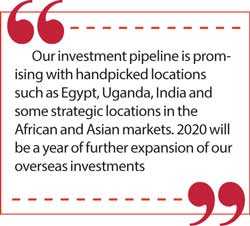 PRASAC to a consideration of $ 603 million subject to NBC’s and FSC’s final approvals. PRASAC is valued at $ 862 million and post-transaction, LOLC will receive $ 603 million.
PRASAC to a consideration of $ 603 million subject to NBC’s and FSC’s final approvals. PRASAC is valued at $ 862 million and post-transaction, LOLC will receive $ 603 million.
Kapila: This deal is a significant milestone for LOLC as well as for Sri Lanka. This is a classic example of value creation. From a country perspective, look at the amount of foreign currency inflow to Sri Lanka as a result of this transaction. I think it is safe to say that this transaction surpasses all other transactions in Sri Lankan corporate history.
We also want to take this opportunity to thank the Central Bank of Sri Lanka for evaluating and granting necessary approvals for the overseas investments we have made.
Q: PRASAC contributed significantly to the group top and bottom line. How do you manage in the medium to long term with no PRASAC in the group?
Kapila: We don’t keep all our eggs in one basket. This is why we have a fairly healthy diversified business portfolio. And with the sales proceeds of PRASAC, we are on a better footing to reinvest in other markets as well as expedite some of our identified investments in the pipeline. This will broad base our investment portfolio for long-term value creation. This transaction will further strengthen our balance sheet and we are very positive about the outlook.
Q: What about the rest of the global expansion?
Ishara: LOLC Cambodia is the second most profitable deposit-taking microfinance institution in 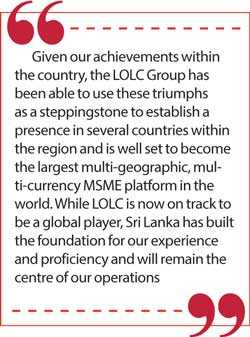 Cambodia. As the only leasing licence-holder among Cambodian MFIs, we are positioning ourselves to do asset-backed lending in a systematic manner. The highlight of the year is that they just passed the $ 1 billion mark in total assets with a portfolio of $ 749 million and a deposit base of $ 420 million by November 2019.
Cambodia. As the only leasing licence-holder among Cambodian MFIs, we are positioning ourselves to do asset-backed lending in a systematic manner. The highlight of the year is that they just passed the $ 1 billion mark in total assets with a portfolio of $ 749 million and a deposit base of $ 420 million by November 2019.
LOLC Myanmar, a Greenfield operation and the first investment of its kind from Sri Lanka in Myanmar, has now become the third largest MFI in the country among its 174 market players in just over five years of operation. This is a significant achievement considering the environment in which we started off in 2013. Myanmar has now gained the spotlight with the liberalisation of the market. With an asset base of $ 85 million, a portfolio of $ 58 million and a growing deposit book of $ 10 million, LOLC Myanmar will outshine its peers in the microfinance arena in time to come.
In recognition of LOLC’s outstanding contribution to the microfinance community, the Government of Pakistan and the Sultanate of Oman invited LOLC to take up the major shareholding of their joint venture, Pak Oman Bank in 2017. LOLC was one of the few bold investors to venture into the Pakistan market, an underpenetrated economy with limitless potential with a population of over 200 million.
The group ventured into Indonesia in early 2018, acquiring controlling interest in Sarana Sumut Ventura (SSV). In a little over a year into the investment, the company now has 20 branches in the regions of Java and Sumatra Islands. With a population of over 265 million and more than 40% of households classified as ‘very poor’, LOLC Indonesia is poised to accomplish the group’s long-term vision of alleviating poverty by empowering women and micro-entrepreneurs.
Our two investments in the Philippines are also thriving on the group’s social mission - LOLC ASKI Finance and LOLC Development Bank, both carefully identified for their strategic locations, where the former will penetrate the northern part and the latter the central and southern part of the Philippine archipelagos.
Our investment pipeline is promising with handpicked locations such as Egypt, Uganda, India and some strategic locations in the African and Asian markets. 2020 will be a year of further expansion of our overseas investments.
Q: What challenges do you face when going international and how do you overcome them?
Kapila: You are right, going international has its own set of challenges and differs from country to country. For instance, language may be the biggest issue in one country and religion may be in another. Cultural barriers are something that we must tread carefully with. Then there are the usual challenges such as political instability, macroeconomic uncertainties, currency devaluation, ad-hoc regulatory measures, etc.
Q: What about Sri Lanka?
Kapila: LOLC started off in 1980, in the backdrop of an open economy as the pioneer leasing company. Looking back, LOLC has come a long way from its mere leasing status to become a one-stop shop for financial solutions to the most profitable conglomerates in Sri Lanka. Today, we own three regulated NBFIs including the largest NBFI in the country, eight listed entities in both the financial and non-financial sector. It was in Sri Lanka that LOLC became a household name in microfinance first before we made ourselves a brand in the region. Sri Lanka will certainly remain our base for expertise and knowledge transfer because our core strengths and culture are home-grown, and it is where we have mastered our competitive edge and the platform on which we build our overseas operations.
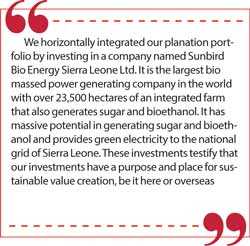
Ishara: With its signature strength in uplifting and empowering grassroots level entrepreneurs, the LOLC brand name has become synonymous with facilitating financial inclusion. The financial portfolio has expanded to serve every aspect of the value chain, comprising an innovative and customised product mix which has been instrumental in setting LOLC apart from the rest. The group’s presence in Sri Lanka spans every district, serving all demographics from top corporates to the bottom of the pyramid, functioning as a catalyst in transforming communities and revolutionising industries through its sustainable, inclusive financing approach and commitment to poverty alleviation. Our success has attracted much international acclaim, reinstated by LOLC’s longstanding international funding partners and DFIs, comprising the largest array of funders for a Sri Lankan NBFI.
Given our achievements within the country, the LOLC Group has been able to use these triumphs as a steppingstone to establish a presence in several countries within the region and is well set to become the largest multi-geographic, multi-currency MSME platform in the world. While LOLC is now on track to be a global player, Sri Lanka has built the foundation for our experience and proficiency and will remain the centre of our operations.
Q: You diversified and invested in hotels and plantations, what was the thinking behind this move?
Ishara: Having established LOLC to be one of the largest NBFI groups in Sri Lanka with strong inroads in the region, we wanted to take a fresh look at our vision. As a result, we embarked on a strategic plan in pursuit of a paradigm shift towards becoming a diversified conglomerate. With the dawn of an era of peace in sight at the time, growth sectors such as leisure, construction, renewable energy and plantations were identified as the ideal first steps in extending our portfolio into the non-financial sphere.
Kapila: We achieved this through our subsidiary Brown and Company, the 145-year-old conglomerate with a diversified business portfolio. Within a few short years of the initial investment, we became the third largest leisure player in the country with five local properties and a few coveted properties in Male and other atolls. Leisure is, however, not our forte, so we have chosen industry experts to run the show for us while we remain involved at a strategic level. We are pleased to have partnered The Barceló Hotel Group, a world-renowned hotel chain, which has signed on to manage five leisure properties of Browns Hotels and Resorts in Sri Lanka and Maldives. This historic venture marks Barceló Hotel Group’s maiden venture into the Asian region, where they will join Browns Investments in developing three five star hotels with a total of 470 keys in North Male Atoll under Bodhufaru Finolhu with a value of $ 150 million. Barceló will operate these properties along with a resort in Bodufinolhu with 100 rooms in the South Ari Atoll, and a mix development - Nasandhura Palace, the most sought-after real estate in Male. In Sri Lanka, Barceló will be the operator for the five star property in the southern coast, The Eden Resort and Spa with 158 keys and The Paradise Resort and Spa holding 67 Eco-villas in Dambulla.
Ishara: The move to the plantation sector is entirely on value enhancement. Galoya Plantation was a sugar giant which was abandoned for over 11 years in a country where over 90% of sugar is imported. Today, Galoya has come a long way not only in the rejuvenation of land masses and restoration of production but also with the revitalisation of the plantation. Over 4,000 farmer families are now benefitting from this project which has now created a considerable impact for the North East area. We also have long-term plans for cinnamon production at Maturata Plantations, as we currently have the largest cinnamon plantation in Sri Lanka.
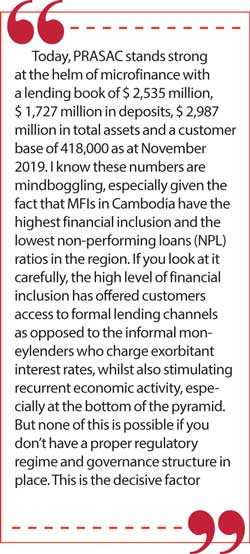
We horizontally integrated our planation portfolio by investing in a company named Sunbird Bio Energy Sierra Leone Ltd. It is the largest bio massed power generating company in the world with over 23,500 hectares of an integrated farm that also generates sugar and bioethanol. It has massive potential in generating sugar and bioethanol and provides green electricity to the national grid of Sierra Leone. These investments testify that our investments have a purpose and place for sustainable value creation, be it here or overseas.
Q: You are widely known for your use of financial technology. Can you reveal how it has helped the group?
Kapila: Technology has played a pivotal role in the expansion of LOLC’s footprint, with specialised architecture produced in-house. We constantly digitalise our processes with state-of-the-art tools and applications. We were the first to provide tablets to all our credit officers with real-time system access during their field visits. We also introduced Robotics Process Automation to Sri Lanka in 2018, along with Field Force Automation and Smart Collect, an automated collection platform, which uses machine learning technology to automate collections and payment follow-up.
In line with this spirit of innovation, LOLC Finance Plc has introduced an internationally acclaimed mobile payment platform, iPay, and was also the first NBFI to introduce a sophisticated online banking platform (LOLC Realtime). We were the first NBFI in the country to obtain SWIFT codes and to be listed in The Banker’s Almanac. Our IT arm deploys in-house tech specialists to our foreign operations to assist with the adoption of the group’s home-grown Fin-Tech platforms in overseas operations.
Q: Do you have any new line of business in mind?
Ishara: Yes, we are highly taken up with the use of advanced scientific technologies to optimise productivity and efficiencies, be it for value addition in industries or value creation in growth sectors such as agriculture. To throw in a couple of examples, through nanotechnology interventions we got into rice fortification where we can infuse nutritional inputs such as iron and zinc into rice to fight malnutrition situations around the world. We have two international patents for this process.
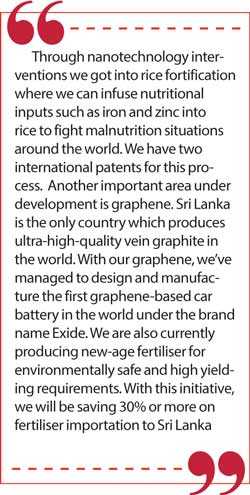
Another important area under development is graphene. Sri Lanka is the only country which produces ultra-high-quality vein graphite in the world. With our graphene, we’ve managed to design and manufacture the first graphene-based car battery in the world under the brand name Exide. We are also currently producing new-age fertiliser for environmentally safe and high yielding requirements. With this initiative, we will be saving 30% or more on fertiliser importation to Sri Lanka. We work closely with the Sri Lanka Institution of Nano Technology (SLINTEC) where LOLC has invested as a strategic partner, and we are very excited by what’s in store.
Q: What does LOLC have in store for the future?
Kapila: Diversifying our portfolio by expanding regionally has offered us resilience, financial stability and a well spread risk profile, which had enabled the group to stride ahead with consistent performance even in turbulent times. Therefore, I am confident in LOLC’s ability to weather challenges and continue on our path of innovation and expansion.
None of this would be possible without our key strength in human capital, with our dynamic workforce with teams of specialists across a range of disciplines, maintaining varied portfolios around the world, to keep us on track with our goals.
Ishara: Our journey continues as we go on exploring opportunities that arise around the world, where there is a population of over one billion in terms of identified markets in the pipeline. We will look to extend our position as a global player and maintain a healthy product mix powered by our strength in innovation. As LOLC is turning 40 this year, we are excited to grow into new markets in Asia, Africa and Latin America.
